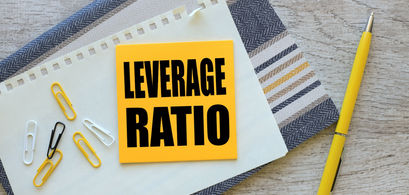Generally, companies have two options when they wish to raise money. They can issue shares of stock, which are also known as equities. Alternatively, they can issue bonds, which are also known as debt instruments. Leverage ratios tell investors how much debt a company has outstanding relative to the equity in their capital structure.
We're going to start this topic with a brief discussion of leverage, and why it's an important concept for investors to understand. Next, we'll review the four most common debt ratios. Then we'll finish up with the pros and cons of using these financial metrics.
Measuring Leverage
The terms debt and leverage are often used interchangeably. Creditors lend money to companies and are paid a rate of interest to compensate them for both the use of that money as well as for assuming the risk of non-payment. If a company cannot make payments to bondholders, these creditors have the first claim to the assets of the company.
For example, if a company does not generate enough profits to pay money owed to bondholders, creditors can force the company to sell its assets to help repay this money. This process is referred to as a bankruptcy proceeding.
When a company holds a great deal of debt, relative to the money provided by the owners of the company (common stockholders), it is said to be highly leveraged. It's important for investors to understand how much leverage a company is using as part of their capitalization structure. The more debt a company holds relative to equity, the greater the risk the company could be forced into bankruptcy. Leverage ratios allow investors to gain insights into the use of debt versus equity.
Debt Ratio
The first metric we're going to examine is called the debt ratio because it measures the liabilities of the company relative to total assets. The balance sheet formula tells us Assets = Liabilities + Owner's Equity. By dividing liabilities by assets, this ratio provides insights into the proportion of debt used to finance the assets of the company.
Formula
Debt Ratio = Total Liabilities / Total Assets
Interpretation
As is the case with many financial ratios, benchmark comparisons should be made against companies in similar industries. That being understood, the higher the ratio of liabilities to assets, the greater the risk creditors could force the company into bankruptcy if it falls behind on interest payments. Generally, it's desirable to have a debt ratio that is less than 0.5. When a company's ratio rises above 0.5, it is said to be highly leveraged.
Debt to Equity Ratio
This next metric compares liabilities to owner's equity. In doing so, this measure tells the analyst how much debt is used to finance the company's assets relative to equity. As was the case with the debt ratio, a lower value offers more protection from creditors if the company falls on difficult financial times.
Formula
Debt to Equity = Total Liabilities / Owner's Equity
Interpretation
It's very common for businesses to borrow money to fuel their growth. This is especially true for companies in capital intensive industries such as electric utilities and automobile manufacturers. As long as these capital investments provide additional profits to the business, making interest payments to creditors is not problematic. However, if the company's business suddenly contracts, they may not have enough profits to pay creditors.
Debt to equity ratios can vary greatly by industry. In December 2018, both Public Service Enterprise Group and Exelon had ratios around 1.0. These values contrast greatly with companies like Google, Apple, and Microsoft, which have ratios below 0.4.
Interest Coverage
While the earlier ratios were derived from the balance sheet, the data used for interest coverage, also known as times interest earned, comes from the income statement. The measure provides analysts and creditors with an indication of a company's ability to meet its interest payments using income generated by ongoing operations.
Formula
Interest Coverage = Operating Income / Interest Expense
Interpretation
As a general rule, the interest coverage ratio should be around 3.0 or higher. Once again, benchmarks and comparisons should be made between companies in similar industries. That being said, if this ratio falls below 1.0, the company may have trouble paying the interest due on its loans. Default occurs when a company cannot meet its obligations under the terms agreed to with creditors. Defaulting on a loan is often a precursor to bankruptcy.
Pros and Cons
One of the big advantages financial ratios have to offer investors is their simplicity. The calculations are typically very straightforward and usually require only a few data points. They provide investors, analysts and creditors with a measure that can be used to benchmark an industry.
They're also a snapshot in time, using information appearing in the company's income statement or balance sheet. As such, it's important to remember that past performance is not always indicative of future results. Finally, the simplicity of these measures can lead to analytical laziness. Debt ratios, along with other metrics such as profitability and liquidity, should be used to paint a holistic picture of the company's financial health.




